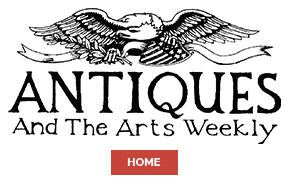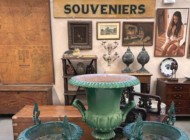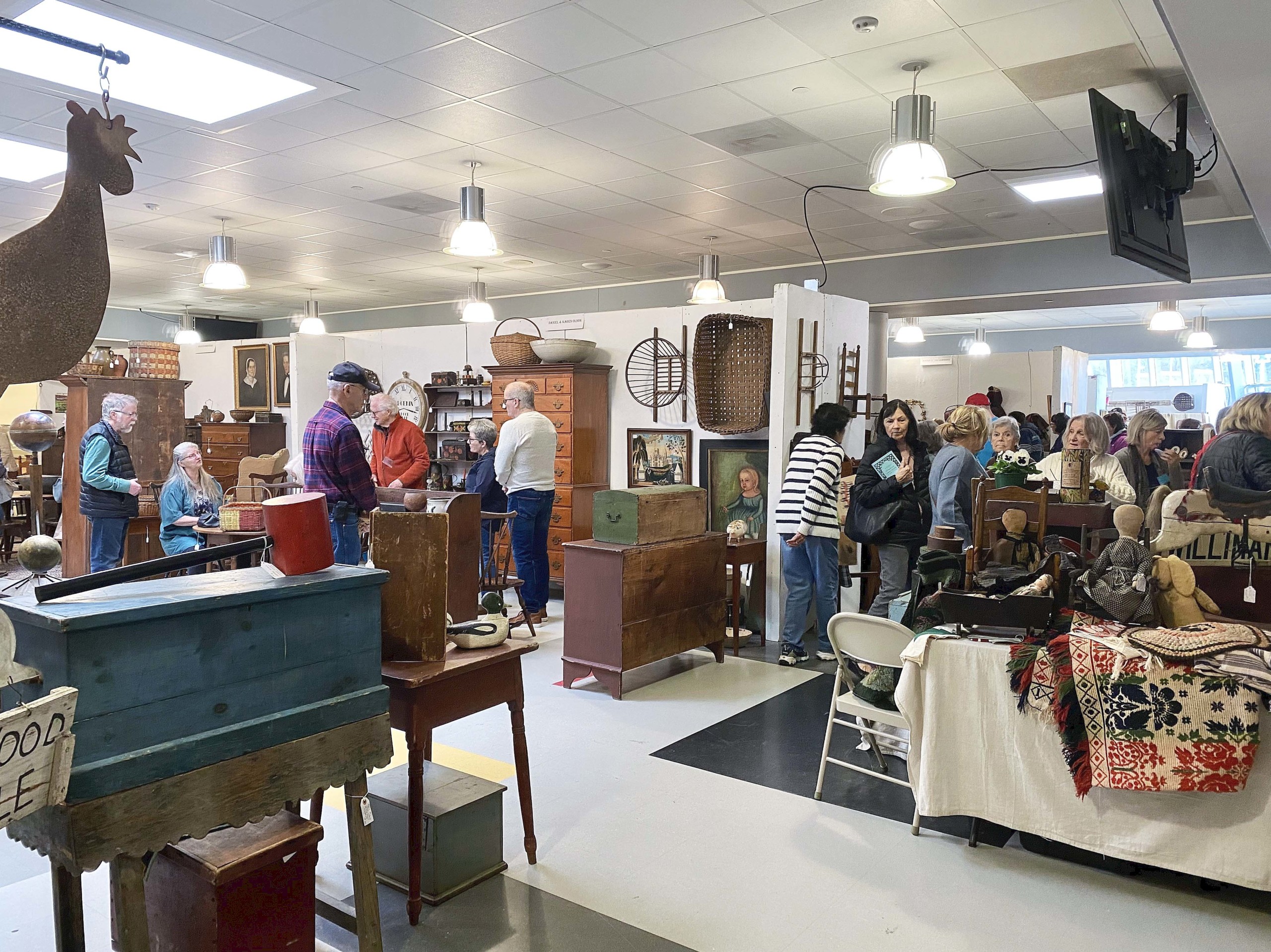
A rare moment of elbow room was needed to capture this corner of the show’s cafeteria booth setup.
Review & Onsite Photos by Z.G. Burnett
DANIELSON, CONN. — The H.H. Ellis Technical High School was anything but quiet on March 29, when its Parent Faculty Organization (PFO) hosted the 31st Country Antiques in Connecticut’s Quiet Corner show. More than 50 dealers from New England and nearby states spread their tables in three large rooms of the school, all stacked with goods. The next day, the event was reported as “one of [their] best shows ever.”
“We still stick with the country theme, which works for everyone,” said Jan Praytor, one of the show’s coordinators and a retired Ellis Tech teacher. “The show has a cohesive look, appeals to a wide range of pocketbooks, our dealers return year after year and our customers are die-hard fans of American country antiques…a win-win-win-win.”
The show is a true team effort with departments for construction, set-up and food preparation. Ingredients are donated along with volunteers’ time to prepare the show’s menu. Ellis Tech students and alumni with young families were spotted throughout the crowds of customers.
“It began as a labor of love in the early 90s as a school fundraiser and has become a passion project of the Parent Faculty Organization,” explained Praytor. “When it began, both the school director at the time, Ernie Gelinas (whose wife was a dealer) and I knew we wanted to have a country show like the old Granby [Mass.] and Avon [Conn.] shows, and we wanted booths with backdrops.”
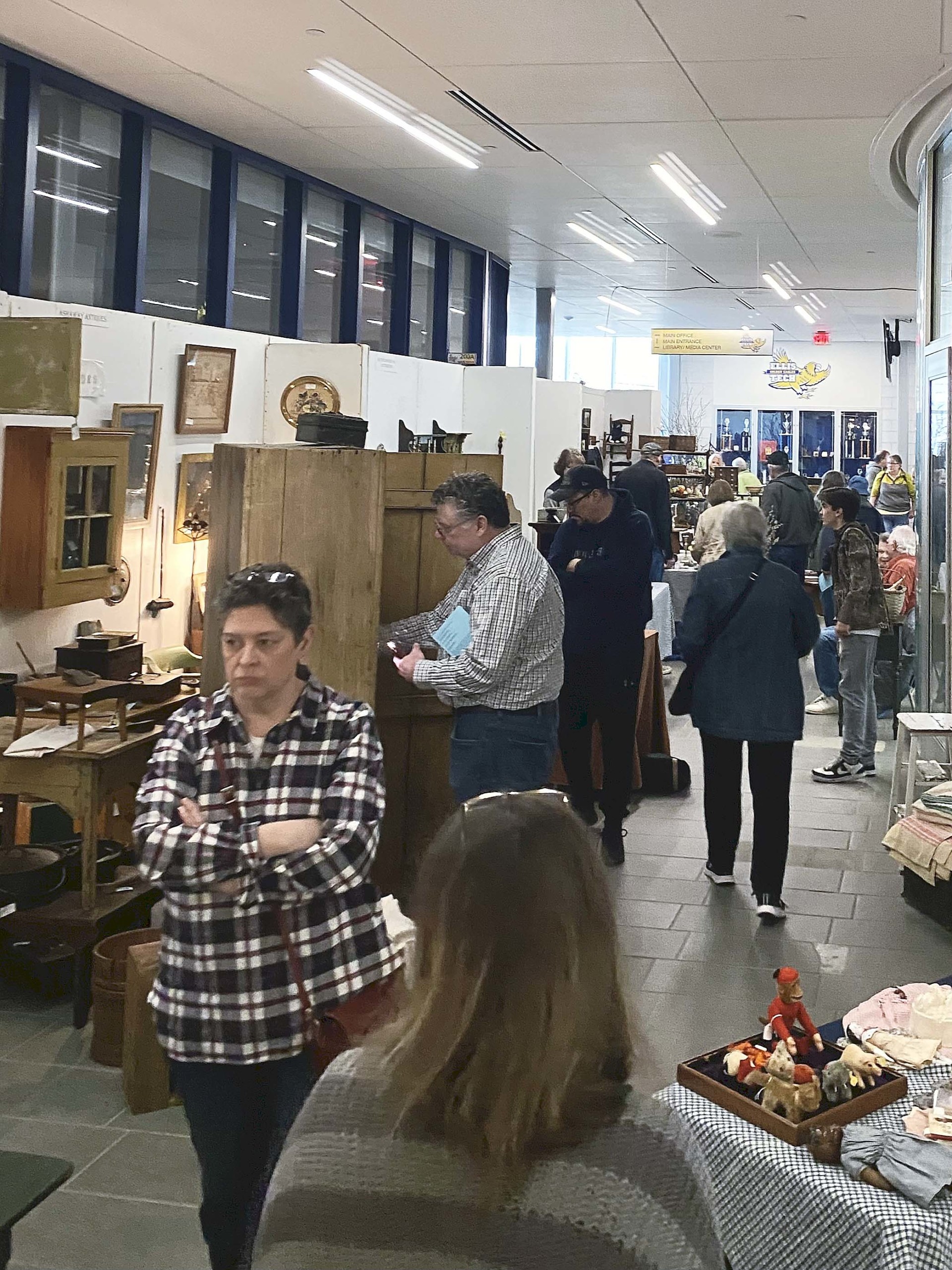
Booths lined the hallway of Ellis Tech’s foyer, providing even more material for treasure-hunting customers.
After trying to find promoters who would take a chance on “an out-of-the-way venue,” the PFO realized that the resources they needed were right there at the school. They began with two shows per year, first in an older school building and then in an airplane hangar where Ellis Tech had an aircraft workshop. School building renovations and the pandemic caused the show to take a few years off, but it’s now back in full operation thanks to PFO members and volunteers from all areas of the community.
Students who participate benefit from the “real life” learning experiences, especially meeting the tight deadlines of an antiques show’s schedule. This year, carpentry and electrical students built and set up lighting for booths that were painted by students from the plumbing track. “I’m most proud of the students who act as porters for the dealers before and after the show,” Praytor commented. “They are enthusiastic to volunteer, and every year they receive rave reviews from the dealers for their care, competence and charming personalities.”
The pride and passion for the show was reflected in the way dealers set up each of their booths, mostly keeping with the country theme and staging rooms filled with merchandise. Milltown Primitives, North Stonington, Conn., recreated an entire early hearth, complete with hooks and shelves to store pewter, redware, stoneware, baskets and all the other storage containers that would be found in a period pantry. The Walker Homestead, Brookfield, Mass., took more of a parlor or bedroom route with its décor. In the booth’s far corner was a Rhode Island Goddard school armchair reupholstered with contemporary crewel work by Angel House Designs, Brookfield, Mass., that already sported a “sold” sign early after the public opening hour. The buyer was fortunate indeed, as a dossier of the chair’s discovery and refurbishment, including photographs, came with the purchase. Next to it was a cherrywood Queen Anne tall chest, made circa 1780 in the Berkshires. Marked “as found” due to alterations made over the years, the chest retained its original brasses and came from the Boyle Homestead in Gill, Mass. Above these hung two 1847 portraits by Horace Bundy (American, 1814-1883), an itinerant artist who had the foresight to sign and date his work. This pair showed Goshen, N.H., residents Oliver Holt (1796-1876) and Harriet Holt (née Wiley, 1799-1877), at 51 and 48 years old.

Just one corner of the Walker Homestead, Brookfield, Mass., booth, showing a sold Goddard school armchair, a Queen Anne Berkshires tall chest and an intact pair of 1847 Horace Bundy portraits painted in Goshen, N.H.
One of the best aspects of country antiques shows are the unusual objects made by anonymous hands that sometimes baffle even their own dealers. Redware is a staple of the genre and markets are often the best venues for fresh, rare forms. Martin and Kathyann Weber of Cobblestone Antiques, Middletown, N.Y., presented an eye-catching Nineteenth Century redware double-shaped teapot that showed delicate beading on its lower convex edge, neck and lid. The teapot lacked the heft and thickness usually associated with redware, with its only damage seen on the lid’s rims. The delicate handle and spout were in excellent condition. Martin shared that it came from Lancaster County, Penn., and had been in their personal collection for years.
Colette Donovan, Merrimacport, Mass., brought a long hooked runner that was similarly distinct yet much easier to spot from across the room. Its flower and swag pattern was rendered in a more sizable scale than other rugs of its kind, owing to the runner’s large gauge of wool that was sheared as well as hooked. In addition to this technique, Donovan believed the runner to have Shaker origins because its maker used another cotton rug as a base. Like the Webers’ teapot, she had never seen its like.
Another large piece was a distinctive corner cupboard brought by Joan Staufer, Catskill, N.Y., which we came upon mid-haggle. After giving the prospective buyers some space, Staufer shared that the Eighteenth Century cupboard was another unprecedented and exciting discovery. “I just knew it was [from] Upstate New York when I saw it,” Staufer explained, indicating the specific shelf shape and regional details. The carved latticework on the upper case, however, was a first for her shop. Inset on flanking square pedestal columns, four-pointed stars decorated the negative space around two beveled ovals that seemed to have no particular purpose. That is, until Staufer realized that they may have once held portraits and indeed found some supports on the inner surface during our conversation. She smiled wide, having never noticed that before.
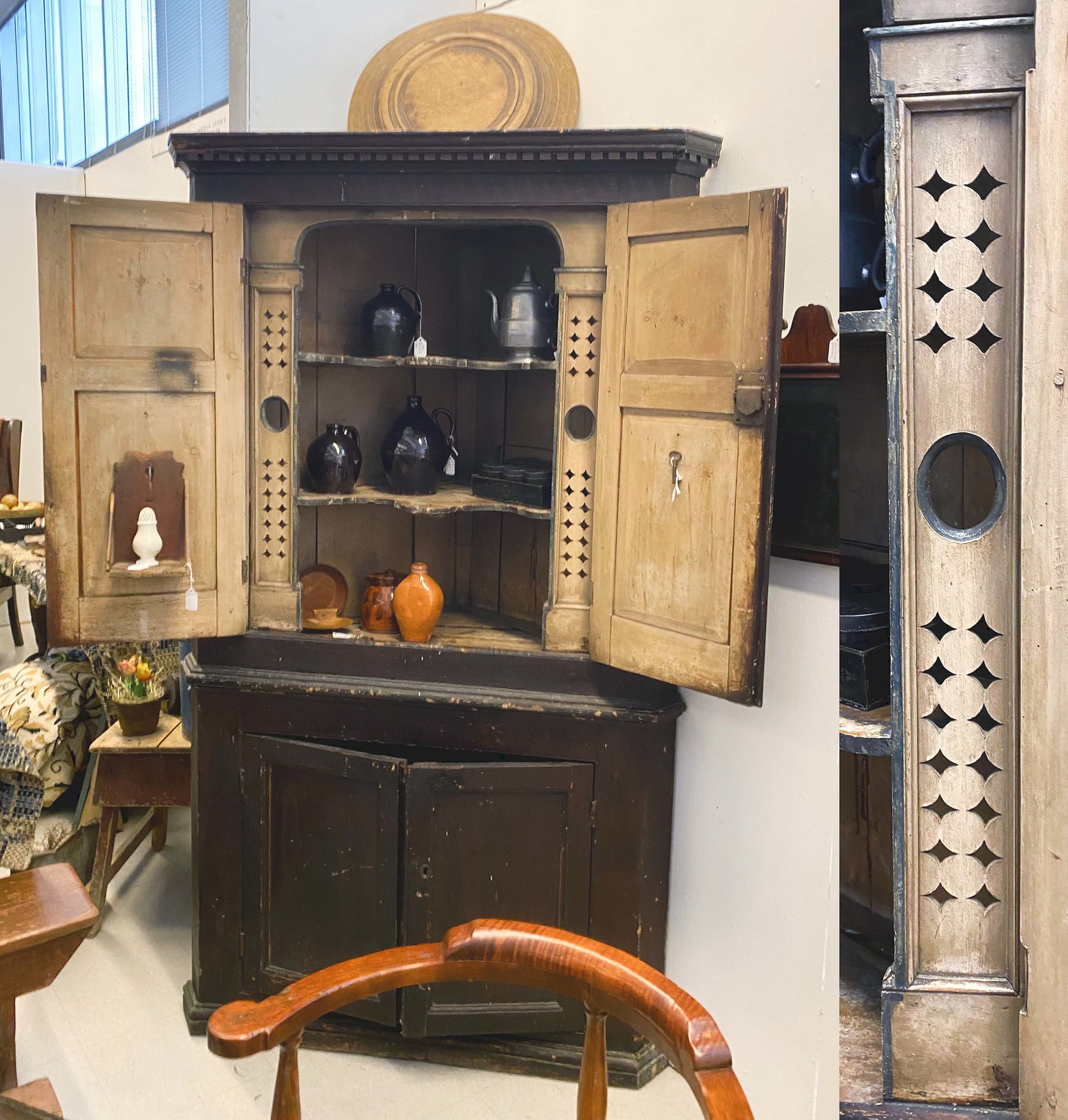
This spacious Eighteenth Century corner cupboard was made in Upstate New York, possibly the Hudson Valley, and may have once held portraits in its beveled oval cutouts. Joan Staufer, Catskill, N.Y.
Other objects came with their stories inscribed on the surface for all to see. Such was the case with a Scandinavian chip and scroll carved storage box from W.S. Korzick Antiques, New Haven, Conn. Made in 1817, according to the lid’s carvings, the meticulously decorated box showed its owner’s name on the outer and inner surfaces and was numbered “127.” It was constructed with wooden pegs and fine strips of birch bark stitching that held the strap together and showed residual polychrome paint on the exterior. As described by the dealer, the box “[appeared] to be absolutely untouched with a marvelous 200 year old patina in outstanding condition.”
Stephen C. Burkhardt Antiques, Antrim, N.H., brought a leather case with even more deliberate documentation, as the circa 1826 broadside advertisement for its maker was pasted to the fresh-looking lining paper. James Boyd (1793-1855), “Saddler,” was an Irish immigrant who owned and operated a rubber hose factory at 27 Merchants Row, Boston, now home to a restaurant on Faneuil Hall Square. Boyd patented his rubber-lined hoses in 1821, which could withstand greater pressure and pump out a higher volume of water than riveted leather hoses. He was a prominent Boston firefighter and later a state legislator. The case was in a remarkable state of preservation, and Burkhardt was especially enthralled by the two-tone leather and brass tack decoration on its exterior.
One more case worthy of note for its origins as well as its painted decoration was with Randi Ona of Wayne, N.J. Detailed white horses with bridles and saddles reared up among flowers in a black-paint border against a dark green field, with carved and painted starburst on the lid. The miniature six-board chest was made in the Mahantongo Valley, a Lenape name that translates to “where we had plenty of meat to eat.” It was once part of Berks County, Penn., and is now in Schuylkill County, bordered by the Blue Mountains of the Appalachian chain. The style of furniture created between 1798 and 1828 in the Schwaben Creek area of the valley has become a recent subject of academic study, and this chest was a prime example.
The 32nd Country Antiques in Connecticut’s Quiet Corner show will occur next year, with an exact date to be announced this season. For information, www.countryantiqueshow.com.
